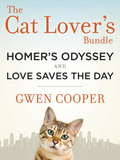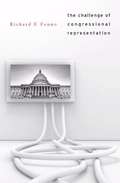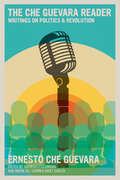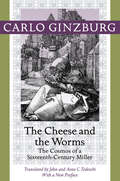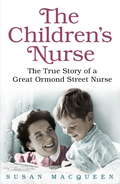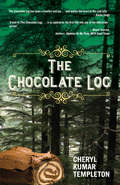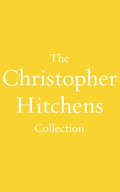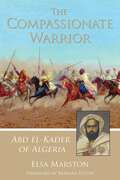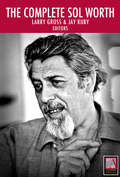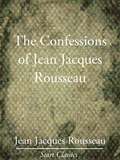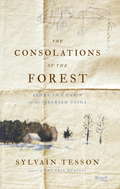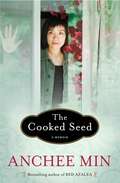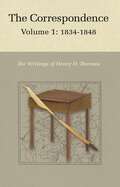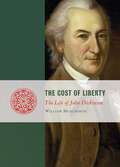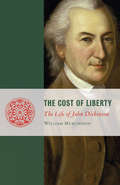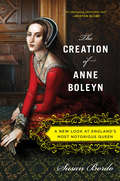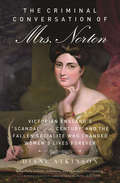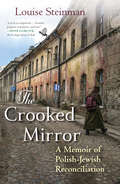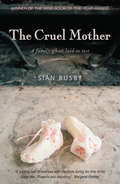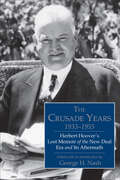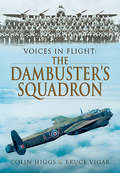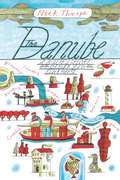- Table View
- List View
The Cat Lover's Bundle: Homer's Odyssey and Love Saves the Day (2-Book Bundle)
by Gwen CooperAs an acclaimed writer of both fiction and nonfiction, Gwen Cooper touches readers with heartwarming and often surprising insights into the bond between humans and their animal companions. Featuring Cooper's inspiring memoir, Homer's Odyssey, and her cat-narrated novel, Love Saves the Day, this eBook bundle is perfect for readers who've ever known unswerving feline devotion, fallen asleep with a purring kitten nestled in their arms, or wondered what their cat was really thinking. HOMER'S ODYSSEY A Fearless Feline Tale, or How I Learned About Love and Life with a Blind Wonder Cat "Touching . . . one not to miss."--USA Today The last thing Gwen Cooper wanted was another cat. She already had two, not to mention an underpaying job and a recently broken heart. Then Gwen's vet called with a story about a three-week-old eyeless kitten who'd been abandoned. It was love at first sight. Everyone warned that Homer would be an "underachiever," but the kitten nobody believed in quickly grew into a three-pound dynamo who scaled seven-foot bookcases, survived alone for days after 9/11 in an apartment near the World Trade Center, and even saved Gwen's life when he chased off a home intruder. By the time Gwen met the man she would marry, Homer had taught her the most valuable lesson of all: Love isn't something you see with your eyes. LOVE SAVES THE DAY A Novel "Prudence [is a] sassy but sensitive feline heroine."--Time When five-week-old Prudence meets a woman named Sarah in a deserted construction site on Manhattan's Lower East Side, she knows she's found the human she was meant to adopt. For three years their lives are filled with laughter, tuna, catnaps, music, and the unchanging routines Prudence craves. Then one day Sarah doesn't come home. When Sarah's estranged daughter and her husband arrive with boxes, Prudence knows that her life has changed forever. Poignant, insightful, and laugh-out-loud funny, Love Saves the Day is the story of a mother, a daughter, and the irrepressible feline who becomes the bridge between them. Prudence, a cat like no other, is sure to steal your heart. Praise for Gwen Cooper Homer's Odyssey "Moving, insightful, and often hilarious, Homer's Odyssey is about a blind cat with a spirit of epic proportions. Read and rejoice!"--Sy Montgomery, author of The Good Good Pig "Cooper is a genial writer with both a sense of humor and a gift for conveying the inner essence of an animal. . . . The indefatigable feline should be an inspiration to us all."--The Christian Science Monitor "A wonderful book for animal lovers."--Temple Grandin, author of Animals in Translation Love Saves the Day "[A] poignant tale . . . [Gwen Cooper] once again demonstrates her compassionate fluency in felinespeak and proves equally adept at conveying complex human emotions with flair and sensitivity."--Booklist "A reason to stand up and cheer . . . Once again Gwen Cooper shines her light on the territory that defines the human/animal bond."--Jackson Galaxy, star of My Cat from Hell and author of Cat Daddy "A charming story of love lost and found . . . Love Saves the Day eloquently explains why so many of us would do anything at all for our pets."--Barbara Delinsky, New York Times bestselling author of Escape
The Challenge of Congressional Representation
by Richard F. FennoAt a moment when Congress is viewed by a skeptical public as hyper-partisan and dysfunctional, Richard Fenno provides a variegated picture of American representational politics. The Challenge of Congressional Representation offers an up-close-and-personal look at the complex relationship between members of Congress and their constituents back home.
The Che Guevara Reader: Writings on Politics & Revolution
by David DeutschmannSelected writings—speeches, essays, and letters—by one of the most widely known guerilla fighters, political theorists, and organizers, Che Guevara.Widely revered as a true revolutionary, this collection of writings from Ernesto Che Guevara highlight his principled politics and praxis in the fight against capitalism and US imperialism. Incisive speeches, critical essays, and personal letters not only serve as a primer of the Cuban revolutionary movement, but also analyze the importance of practicing international solidarity, reflect on violent resistance, and explicate the dangerous failures of capitalism.Accompanied by an extensive bibliography of Guevara's writing, a timeline of his life, and an all-encompassing glossary of individuals, organizations, and publications, the Che Guevara Reader provides insights into the historical, political, and cultural context for Guevara's radicalization. From some of his most famous speeches such as "Create Two, Three, Many Vietnams" to intimate, personal letters addressed to comrades around the world and his own children, this book extends Che's legacy and paints a stunning picture of a revolutionary struggling for a better world.
The Cheese and the Worms: The Cosmos of a Sixteenth-Century Miller
by Carlo GinzburgThe now-classic tale of a sixteenth-century miller facing the Roman Inquisition.The Cheese and the Worms is an incisive study of popular culture in the sixteenth century as seen through the eyes of one man, the miller known as Menocchio, who was accused of heresy during the Inquisition and sentenced to death. Carlo Ginzburg uses the trial records to illustrate the religious and social conflicts of the society Menocchio lived in. For a common miller, Menocchio was surprisingly literate. In his trial testimony he made references to more than a dozen books, including the Bible, Boccaccio's Decameron, Mandeville's Travels, and a "mysterious" book that may have been the Koran. And what he read he recast in terms familiar to him, as in his own version of the creation: "All was chaos, that is earth, air, water, and fire were mixed together; and of that bulk a mass formed—just as cheese is made out of milk—and worms appeared in it, and these were the angels."Ginzburg’s influential book has been widely regarded as an early example of the analytic, case-oriented approach known as microhistory. In a thoughtful new preface, Ginzburg offers his own corollary to Menocchio’s story as he considers the discrepancy between the intentions of the writer and what gets written. The Italian miller’s story and Ginzburg’s work continue to resonate with modern readers because they focus on how oral and written culture are inextricably linked. Menocchio’s 500-year-old challenge to authority remains evocative and vital today.
The Children's Nurse: The True Story of a Great Ormond Street Nurse
by Susan MacqueenThe memoir of a Great Ormond Street nurse.This is the inspirational story of life as a nurse during the 1960s, 70s and 80s, most of which was spent at Great Ormond Street Children's Hospital. Susan Macqueen was 12 years old when she accompanied her mum to see her friend Ms Fairweather, the matron at the local nursing home and from that day on she knew she wanted to be a nurse. A few years later, despite being told that her grades weren't good enough and having left school with only two O-Levels, Susan was accepted on the three-year nurses training course at Addenbooke's hospital in Cambridge. It wasn't long before Susan knew she wanted to work with children and set her sights on a job at Great Ormond Street. Thirty-five years later, on her third attempt, Susan has finally retired from that iconic hospital and is enjoying a more leisurely pace of life.Hope, despair, laughter and tears, Susan's stories move the reader through the incredible stories that she was faced with on an every day basis.
The Chocolate Log
by Cheryl Kumar TempletonThe Chocolate Log has been a comfort and joy to come to over the years. The love Cheryl puts into her food and the joy and laughter served in many forms warms the heart in the cold hills. The taste of home like it was in the good old days when a warm hearth meant something was baking. – Rocky Singh, Anchor, Award winning series Highway on My Plate, NDTV Goodtimes The Chocolate Log is the story of Cheryl Kumar Templeton, a schoolteacher, and her husband Allan, an Indian Air Force fighter pilot, who gave up their secure comfortable careers to start a new life in Mcleodganj, a suburb situated in the foothills of the Himalayas, which Cheryl describes as ‘a microcosm of the whole world’. It was here that a new dream unfolded, and in its wake was born The Chocolate Log, a patisserie and café they have run for twenty-four years, and continue to do so till today. She writes with sympathy and affection of the local people – the Himachalis, the Tibetans, the Gaddis; of the people who slipped in and out of their lives: some of whom returned again and again to their 'karmic mountain', a destination for the soul; others who have stayed on in their memories: the idealists, the visitors who became soul friends, the eccentrics, the loonies. She generously shares with readers the recipes of a few of her many popular offerings – brown bread, chicken quiche, chocolate cake, lemon tarts, apple pie and even the special train cake she made for her granddaughter’s first birthday – which have gained her mention in the New York Times, Lonely Planet, Frommer’s, The Rough Guide, Footprints and other multi-language travel guides. But this book is not only about recipes or running a café. She speaks of the years of slogging through eighteen-hour days; months of no business and no income; of arguments, fights, frustrations, and fatigue. Of heartbreak when her granddaughter was born; of ups and downs, but also of victories – The Chocolate Log, The Cheryton Cottage Guest House, and Wine Oaks, where wines are made according to her grandfather's recipes. In Cheryl's words, ‘This is my story of imagination, successes, disappointments, struggle, pain, criticism, appreciation, but, most of all of magic! At the end of the day, and at the end of my story, I can only say – IT WAS WORTH IT ALL!’
The Christopher Hitchens 4-Book Collection
by Christopher Hitchens"Christopher Hitchens is the greatest essayist in the English language." —Christopher Buckley Christopher Hitchens has long been considered on of the most compelling and intelligent writers and orators on our time. In this four-volume eBook bundle, no subject is left unconsidered in Hitchens's hands: from the case against god and religion in God Is Not Great; to various "Amusements, Annoyances, and Disappointments" in Arguably -- the Ten Commandments, the concept of "funny"; from a memoir tracing his storied life in Hitch-22 to a raw and honest meditation on life and death in Mortality, his last book before his death in 2011. Provocative and perceptive, unabashed and polemical, The Christopher Hitchens 4-Book Ebook Collection is the essential reader for any Hitchens fan. GOD IS NOT GREAT: HOW RELIGION POISONS EVERYTHING HITCH-22: A MEMOIR ARGUABLY: ESSAYS MORTALITY
The Civil War Generals: Comrades, Peers, Rivals: In Their Own Words (Civil War America Ser.)
by Robert I. Girardi“An excellent contribution to Civil War literature . . . . [A]n excellent reference resource. Civil War buffs in particular will greatly enjoy this book.” —ArmchairGeneral.comThe Civil War Generals offers an unvarnished and largely unknown window into what military generals wrote and said about each other during the Civil War era. Drawing on more than 170 sources—including the letters, diaries, and memoirs of the general officers of the Union and Confederate armies, as well as their staff officers and other prominent figures—Civil War historian Robert Girardi has compiled a valuable record of who these generals were and how they were perceived by their peers. The quotations within paint revealing pictures of the private subjects at hand and, just as often, the people writing about them—a fascinating look at the many diverse personalities of Civil War leadership. More than just a collection of quotations, The Civil War Generals is also a valuable research tool, moving beyond the best-known figures to provide contemporary character descriptions of more than four hundred Civil War generals. The quotes range in nature from praise to indictment, and differing opinions of each individual give a balanced view, making the book both entertaining and informative. A truly one-of-a-kind compilation illustrated with approximately one hundred historical photographs, The Civil War Generals will find a home not only with the casual reader and history buff, but also with the serious historian and researcher.
The Collaboration
by Ben UrwandTo continue doing business in Germany after Hitler's ascent to power, Hollywood studios agreed not to make films that attacked the Nazis or condemned Germany's persecution of Jews. Ben Urwand reveals this bargain for the first time--a "collaboration" (Zusammenarbeit) that drew in a cast of characters ranging from notorious German political leaders such as Goebbels to Hollywood icons such as Louis B. Mayer. At the center of Urwand's story is Hitler himself, who was obsessed with movies and recognized their power to shape public opinion. In December 1930, his Party rioted against the Berlin screening of All Quiet on the Western Front, which led to a chain of unfortunate events and decisions. Fearful of losing access to the German market, all of the Hollywood studios started making concessions to the German government, and when Hitler came to power in January 1933, the studios--many of which were headed by Jews--began dealing with his representatives directly. Urwand shows that the arrangement remained in place through the 1930s, as Hollywood studios met regularly with the German consul in Los Angeles and changed or canceled movies according to his wishes. Paramount and Fox invested profits made from the German market in German newsreels, while MGM financed the production of German armaments. Painstakingly marshaling previously unexamined archival evidence, The Collaboration raises the curtain on a hidden episode in Hollywood--and American--history.
The Compassionate Warrior: Abd el-Kader of Algeria
by Elsa MarstonA brilliant military strategist, superb horseman, statesman, philosopher, Muslim saint . . . Emir Abdel Kader (1808-1883) was an international celebrity in his own time, known for his generosity and kindness even towards enemies. Today he is recognized as one of the noblest leaders of the 19th century and a pioneer in interfaith dialogue. This fascinating biography of the heroic Arab who led the resistance to the French conquest of Algeria, endured betrayal and imprisonment, and in 1860, in Syria, saved thousands of innocent people from mob violence brings a vital message for our times.
The Complete Sol Worth
by Larry Gross Jay RubyOne of the central figures in the development of the study of visual communication, Sol Worth (1922-1977) was a filmmaker and painter before he turned to academic pursuits. He began with the question of how film could be understood and studied as medium of communication, and from there, he moved on to larger and more profound questions about the nature of visual media in general and the role that visual images play in shaping and constructing reality. He is perhaps best known for the "Navajo Film Project" that he conducted with anthropologist John Adair in which they gave 16mm cameras to Navajo residents of the Pine Springs, Arizona reservation in order to explore how people who had never made or used movies would do so for the first time. How would their movies reflect their own culture and their ways of seeing and telling about their experiences? The book, Through Navajo Eyes, included here, became enormously influential in the fields of anthropology, communication and cinema studies, among others. In The Complete Sol Worth, editors Larry Gross and Jay Ruby collect all of Sol Worth's published writings, as well as some unpublished writings, extensive photo essays, and articles about Worth's work. Sol Worth's work remains relevant and influential in visual communication and anthropology, and the e-book format enables an accessible collection of the entirety of his contributions. Readers can also access Teaterri, a video documentary that Worth produced which is part of a permanent collection at the Museum of Modern Art in New York. We hope this collection will introduce new readers to Sol Worth's contribution to bettering our understanding of visual communication, culture, and life.One of the central figures in the development of the study of visual communication, Sol Worth (1922-1977) was a filmmaker and painter before he turned to academic pursuits. He began with the question of how film could be understood and studied as medium of communication, and from there, he moved on to larger and more profound questions about the nature of visual media in general and the role that visual images play in shaping and constructing reality. He is perhaps best known for the "Navajo Film Project" that he conducted with anthropologist John Adair in which they gave 16mm cameras to Navajo residents of the Pine Springs, Arizona reservation in order to explore how people who had never made or used movies would do so for the first time. How would their movies reflect their own culture and their ways of seeing and telling about their experiences? The book, Through Navajo Eyes, included here, became enormously influential in the fields of anthropology, communication and cinema studies, among others.
The Confessions of Jean Jacques Rouss
by Jean Jacques RousseauWhen it was first published in 1781, The Confessions scandalised Europe with its emotional honesty and frank treatment of the author's sexual and intellectual development. Since then, it has had a more profound impact on European thought. Rousseau left posterity a model of the reflective life - the solitary, uncompromising individual, the enemy of servitude and habit and the selfish egoist who dedicates his life to a particular ideal. The Confessions recreates the world in which he progressed from incompetent engraver to grand success; his enthusiasm for experience, his love of nature, and his uncompromising character make him an ideal guide to eighteenth-century Europe, and he was the author of some of the most profound work ever written on the relation between the individual and the state.
The Consolations of the Forest
by Linda Coverdale Sylvain TessonA meditation on escaping the chaos of modern life and rediscovering the luxury of solitude. Winner of the Prix Médicis for nonfiction, The Consolations of the Forest is a Thoreau-esque quest to find solace, taken to the extreme. No stranger to inhospitable places, Sylvain Tesson exiles himself to a wooden cabin on Siberia's Lake Baikal, a full day's hike from any "neighbor," with his thoughts, his books, a couple of dogs, and many bottles of vodka for company. Writing from February to July, he shares his deep appreciation for the harsh but beautiful land, the resilient men and women who populate it, and the bizarre and tragic history that has given Siberia an almost mythological place in the imagination. Rich with observation, introspection, and the good humor necessary to laugh at his own folly, Tesson's memoir is about the ultimate freedom of owning your own time. Only in the hands of a gifted storyteller can an experiment in isolation become an exceptional adventure accessible to all. By recording his impressions in the face of silence, his struggles in a hostile environment, his hopes, doubts, and moments of pure joy in communion with nature, Tesson makes a decidedly out-of-the-ordinary experience relatable. The awe and joy are contagious, and one comes away with the comforting knowledge that "as long as there is a cabin deep in the woods, nothing is completely lost."
The Cooked Seed: A Memoir
by Anchee MinMin returns to the story of her own life to give us the next chapter, an immigrant story that takes her from the shocking deprivations of her homeland to the sudden bounty of the promised land of America, without language, money, or a clear path.
The Correspondence Of Charles Darwin: Volume 20 1872
by Janet Browne Frederick Burkhardt James A. Secord Samantha Evans Shelley Innes Francis Neary Alison M. Pearn Anne Secord Paul WhiteThis volume is part of the definitive edition of letters written by and to Charles Darwin, the most celebrated naturalist of the nineteenth century. Notes and appendixes put these fascinating and wide-ranging letters in context, making the letters accessible to both scholars and general readers. Darwin depended on correspondence to collect data from all over the world, and to discuss his emerging ideas with scientific colleagues, many of whom he never met in person. The letters are published chronologically: volume 20 includes letters from 1872, the year in which The expression of the emotions in man and animals was published, making ground-breaking use of photography. Also in this year, the sixth and final edition of On the origin of species was published, and Darwin resumed his work on carnivorous plants and plant movement, finding unexpected similarities between the plant and animal kingdoms.
The Correspondence of Henry D. Thoreau: Volume 1: 1834 - 1848 (Writings of Henry D. Thoreau #24)
by Henry David ThoreauThis is the inaugural volume in the first full-scale scholarly edition of Thoreau's correspondence in more than half a century. When completed, the edition's three volumes will include every extant letter written or received by Thoreau--in all, almost 650 letters, roughly 150 more than in any previous edition, including dozens that have never before been published. Correspondence 1 contains 163 letters, ninety-six written by Thoreau and sixty-seven to him. Twenty-five are collected here for the first time; of those, fourteen have never before been published. These letters provide an intimate view of Thoreau's path from college student to published author. At the beginning of the volume, Thoreau is a Harvard sophomore; by the end, some of his essays and poems have appeared in periodicals and he is at work on A Week on the Concord and Merrimack Rivers and Walden. The early part of the volume documents Thoreau's friendships with college classmates and his search for work after graduation, while letters to his brother and sisters reveal warm, playful relationships among the siblings. In May 1843, Thoreau moves to Staten Island for eight months to tutor a nephew of Emerson's. This move results in the richest period of letters in the volume: thirty-two by Thoreau and nineteen to him. From 1846 through 1848, letters about publishing and lecturing provide details about Thoreau's first years as a professional author. As the volume closes, the most ruminative and philosophical of Thoreau's epistolary relationships begins, that with Harrison Gray Otis Blake. Thoreau's longer letters to Blake amount to informal lectures, and in fact Blake invited a small group of friends to readings when these arrived. Following every letter, annotations identify correspondents, individuals mentioned, and books quoted, cited, or alluded to, and describe events to which the letters refer. A historical introduction characterizes the letters and connects them with the events of Thoreau's life, a textual introduction lays out the editorial principles and procedures followed, and a general introduction discusses the significance of letter-writing in the mid-nineteenth century and the history of the publication of Thoreau's letters. Finally, a thorough index provides comprehensive access to the letters and annotations.
The Cost of Liberty: The Life of John Dickinson
by William MurchisonThe Cost of Liberty offers a sorely needed reassessment of a great patriot and misunderstood Founder. It has been more than a half century since a biography of John Dickinson appeared. Author William Murchison rectifies this mistake, bringing to life one of the most influential figures of the entire Founding period, a principled man whose gifts as writer, speaker, and philosopher only Jefferson came near to matching. In the process, Murchison destroys the caricature of Dickinson that has emerged from such popular treatments as HBO&’s John Adams miniseries and the Broadway musical 1776. Dickinson is remembered mostly for his reluctance to sign the Declaration of Independence. But that reluctance, Murchison shows, had nothing to do with a lack of patriotism. In fact, Dickinson immediately took up arms to serve the colonial cause—something only one signer of the Declaration did. He stood on principle to oppose declaring independence at that moment, even when he knew that doing so would deal the &“finishing blow&” to his once-great reputation. Dubbed the &“Penman of the Revolution,&” Dickinson was not just a scribe but also a shaper of mighty events. From the 1760s through the late 1780s he was present at, and played a significant role in, every major assemblage where the Founders charted America&’s path—a claim few others could make. Author of the landmark essays Letters from a Farmer in Pennsylvania, delegate to the Continental Congress, key figure behind the Articles of Confederation and the Constitution, chief executive of both Pennsylvania and Delaware: Dickinson was, as one esteemed historian aptly put it, &“the most underrated of all the Founders.&” This lively biography gives a great Founder his long-overdue measure of honor. It also broadens our understanding of the Founding period, challenging many modern assumptions about the events of 1776 and 1787.
The Cost of Liberty: The Life of John Dickinson (Lives Of The Founders Ser.)
by William Murchison"Makes a powerful and convincing case for restoring John Dickinson to his rightful place in the first rank of the Founders." --The Washington Times The Cost of Liberty offers a sorely needed reassessment of a great patriot and misunderstood Founder. It has been more than a half century since a biography of John Dickinson appeared. Author William Murchison rectifies this mistake, bringing to life one of the most influential figures of the entire Founding period, a principled man whose gifts as writer, speaker, and philosopher only Jefferson came near to matching. In the process, Murchison destroys the caricature of Dickinson that has emerged from such popular treatments as HBO's John Adams miniseries and the Broadway musical 1776. Dickinson is remembered mostly for his reluctance to sign the Declaration of Independence. But that reluctance, Murchison shows, had nothing to do with a lack of patriotism. In fact, Dickinson immediately took up arms to serve the colonial cause--something only one signer of the Declaration did. He stood on principle to oppose declaring independence at that moment, even when he knew that doing so would deal the "finishing blow" to his once-great reputation. Dubbed the "Penman of the Revolution," Dickinson was not just a scribe but also a shaper of mighty events. From the 1760s through the late 1780s he was present at, and played a significant role in, every major assemblage where the Founders charted America's path--a claim few others could make. Author of the landmark essays Letters from a Farmer in Pennsylvania, delegate to the Continental Congress, key figure behind the Articles of Confederation and the Constitution, chief executive of both Pennsylvania and Delaware: Dickinson was, as one esteemed historian aptly put it, "the most underrated of all the Founders." This lively biography gives a great Founder his long-overdue measure of honor.
The Creation of Anne Boleyn: A New Look at England's Most Notorious Queen
by Susan BordoThis illuminating history examines the life and many legends of the 16th century Queen who was executed by her husband, King Henry VIII. Part biography, part cultural history, The Creation of Anne Boleyn is a fascinating reconstruction of Anne&’s life and a revealing look at her afterlife in the popular imagination. Why is her story so compelling? Why has she inspired such extreme reactions? Was she the flaxen-haired martyr of Romantic paintings or the raven-haired seductress of twenty-first-century portrayals? (Answer: neither.) But the most provocative question of all concerns Anne&’s death: How could Henry order the execution of a once beloved wife? Drawing on scholarship and critical analysis, Bordo probes the complexities of one of history&’s most infamous relationships. She then demonstrates how generations of polemicists, biographers, novelists, and filmmakers have imagined and re-imagined Anne: whore, martyr, cautionary tale, proto &“mean girl,&” feminist icon, and everything in between. In The Creation of Anne Boleyn, Bordo steps off the well-trodden paths of Tudoriana to tease out the human being behind the competing mythologies, paintings, and on-screen portrayals.
The Criminal Conversation of Mrs. Norton: Victorian England's "Scandal of the Century" and the Fallen Socialite Who Changed Women's Lives Fore
by Diane AtkinsonA forgotten heroine of the women's rights movement is rescued from obscurity in this biography of Caroline Norton, a respected poet, songwriter, and socialite whose 1836 adultery trial rocked Victorian England. When George Norton accused his wife of having an affair with the British Prime Minister he sparked what was considered "the scandal of the century." Though she was declared innocent, the humiliated George locked Caroline out of their home, seized her manuscripts, letters, clothes, jewels, and every penny of her earnings, and refused to let her see their three sons. This detailed account of the Norton "criminal conversation" trial sheds vivid light on the desperate position of women in male-dominated Victorian society and chronicles Caroline's lifelong campaign to establish legal rights for married and divorced women, allowing them to inherit property, take court action on their own behalf, and in effect establishing them for the first time as full-fledged human beings before the law. Figuring into this fascinating story are Norton's friend and confidante Mary Shelley, longtime admirer Charles Dickens, Lord Byron, Queen Victoria, and other literary and royal heavyweights of the day.
The Crooked Mirror: A Memoir of Polish-Jewish Reconciliation
by Louise SteinmanA lyrical literary memoir that explores the exhilarating, discomforting, and ultimately healing process of Polish-Jewish reconciliation taking place in Poland today Although an estimated 80 percent of American Jews are of Polish descent, many in the postwar generation and those born later know little about their families' connection to their ancestral home. In fact, many Jews continue to think of Poland as a bastion of anti-Semitism, since nearly the entire population of Polish Jewry was killed in the Holocaust. The reality is more complex: although German-occupied Poland was the site of great persecution towards Jews, it was also the epicenter of European Jewish life for centuries. Louise Steinman sets out to examine the burgeoning Polish-Jewish reconciliation movement through the lens of her own family's history, joining the ranks of Jews of Polish descent who are confronting both Poland's heroism and occupation-afflicted atrocities, and who are seeking to reconnect with their families' Polish roots
The Cruel Mother: A Family Ghost Laid to Rest
by Sian BusbyIn 1919 the author"s great-grandmother, Beth, gave birth to triplets. One of the babies died at birth and eleven days later she drowned the surviving twins in a bath of cold water. She was sentenced to an indefinite term of imprisonment at Broadmoor.
The Crusade Years, 1933–1955: Herbert Hoover's Lost Memoir of the New Deal Era and Its Aftermath
by George H. Nash Editor Herbert HooverCovering an eventful period in Herbert Hoover's career—and, more specifically, his life as a political pugilist from 1933 to 1955—this previously unknown memoir was composed and revised by the 31st president during the 1940s and 1950s—and then, surprisingly, set aside. This work recounts Hoover's family life after March 4, 1933, his myriad philanthropic interests, and, most of all, his unrelenting “crusade against collectivism” in American life. Aside from its often feisty account of Hoover's political activities during the Roosevelt and Truman eras, and its window on Hoover's private life and campaigns for good causes, The Crusade Years invites readers to reflect on the factors that made his extraordinarily fruitful postpresidential years possible. The pages of this memoir recount the story of Hoover's later life, his abiding political philosophy, and his vision of the nation that gave him the opportunity for service. This is, in short, a remarkable saga told in the former president's own words and in his own way that will appeal as much to professional historians and political scientists as it will lay readers interested in history.
The Dambuster's Squadron: The Dambuster's Squadron (Voices in Flight)
by Colin Higgs Bruce VigarThey were the Dambusters the pilots and crew of the RAFs elite 617 Squadron. They flew the most difficult missions. They breached the Dams! They sank the Tirpitz! They were the only squadron to drop the immense Grand Slam bombs and with them they destroyed bridges, viaducts and even Hitlers impregnable U-boat pens.In this unique book, introduced by Dams raid survivor, George Johnny Johnson, authors Colin Higgs and Bruce Vigar present no less than nine exclusive interviews with men who flew and fought in 617 Squadron during the Second World War. These men took part in virtually every operation the Squadron flew and went on some of the most daring and dangerous missions of the war. The result is one of the most vivid and unforgettable accounts of the RAF at war ever written.
The Danube
by Nick Thorpehopkeepers, beekeepers, waitresses, smugglers and border policemen, legal and illegal immigrants, and many more. For readers who anticipate their own journeys on the Danube, as well as those who only dream of seeing the great river, this book will be a unique and treasured guide.
